Finance in Hospitality Report
VerifiedAdded on 2020/10/04
|22
|5156
|24
Report
AI Summary
This report discusses the critical role of finance in the hospitality industry, detailing various funding sources, income generation methods for restaurants, and financial management strategies. It includes analyses of financial statements, budgetary control processes, and recommendations for improving profitability in hospitality businesses.

FINANCE IN
HOSPITALITY
HOSPITALITY
Paraphrase This Document
Need a fresh take? Get an instant paraphrase of this document with our AI Paraphraser
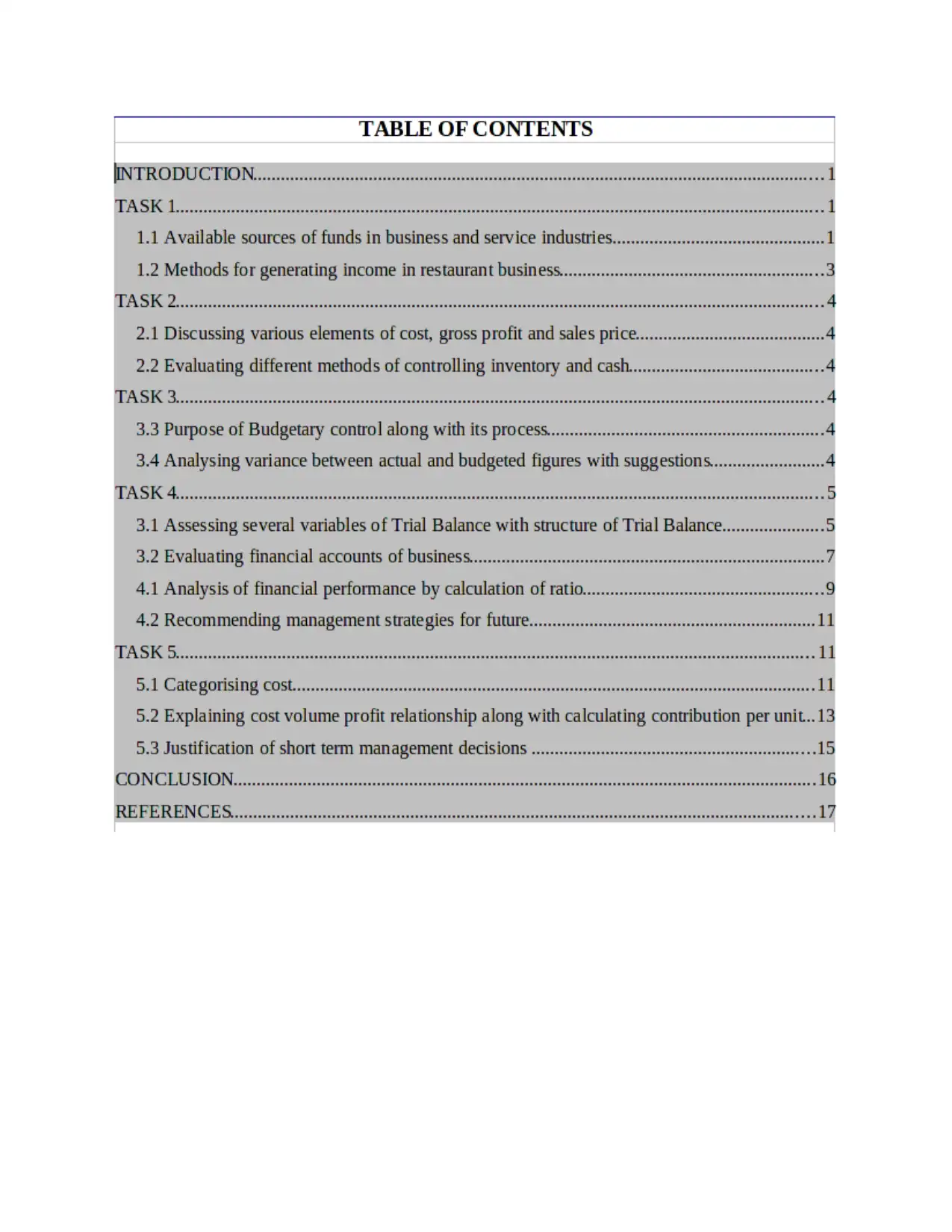
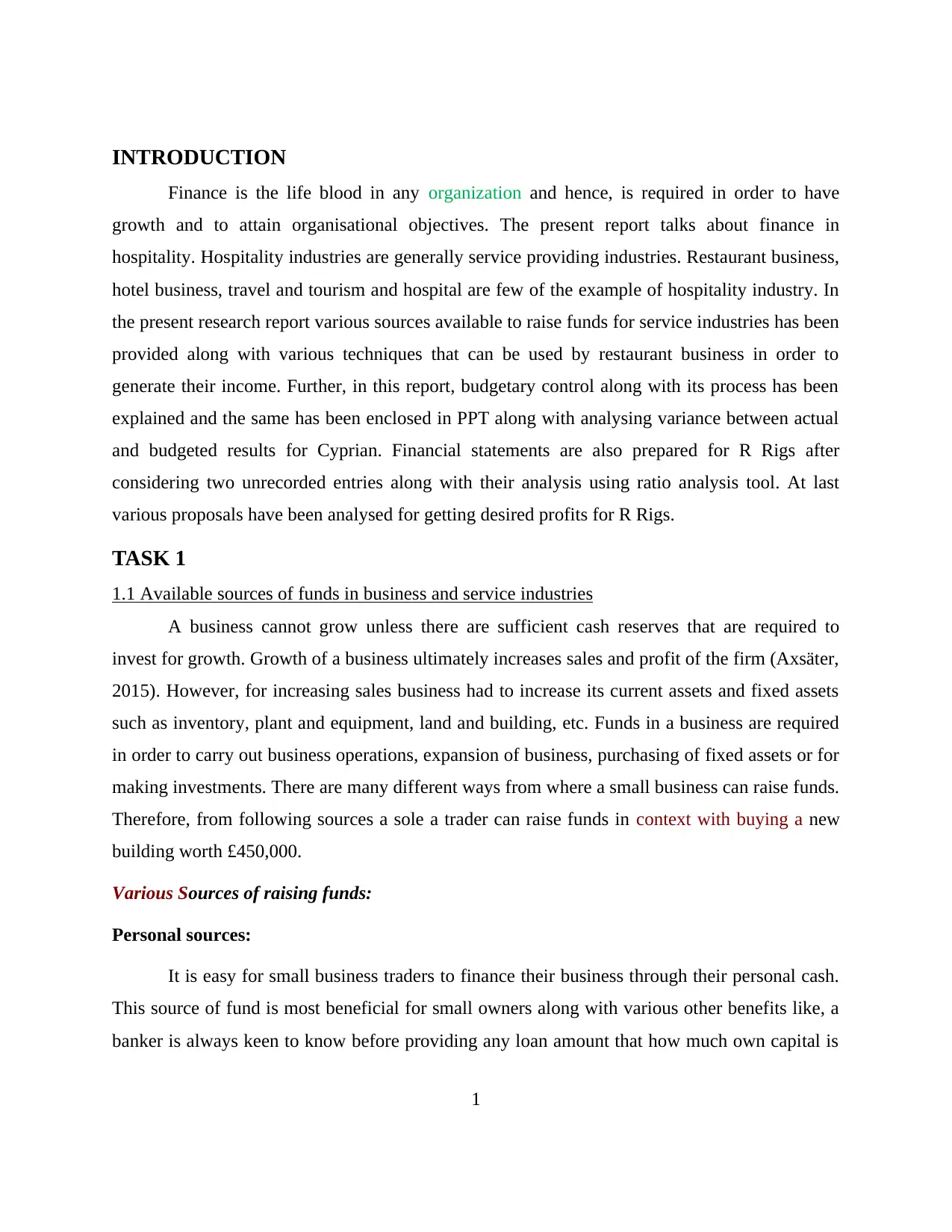
INTRODUCTION
Finance is the life blood in any organization and hence, is required in order to have
growth and to attain organisational objectives. The present report talks about finance in
hospitality. Hospitality industries are generally service providing industries. Restaurant business,
hotel business, travel and tourism and hospital are few of the example of hospitality industry. In
the present research report various sources available to raise funds for service industries has been
provided along with various techniques that can be used by restaurant business in order to
generate their income. Further, in this report, budgetary control along with its process has been
explained and the same has been enclosed in PPT along with analysing variance between actual
and budgeted results for Cyprian. Financial statements are also prepared for R Rigs after
considering two unrecorded entries along with their analysis using ratio analysis tool. At last
various proposals have been analysed for getting desired profits for R Rigs.
TASK 1
1.1 Available sources of funds in business and service industries
A business cannot grow unless there are sufficient cash reserves that are required to
invest for growth. Growth of a business ultimately increases sales and profit of the firm (Axsäter,
2015). However, for increasing sales business had to increase its current assets and fixed assets
such as inventory, plant and equipment, land and building, etc. Funds in a business are required
in order to carry out business operations, expansion of business, purchasing of fixed assets or for
making investments. There are many different ways from where a small business can raise funds.
Therefore, from following sources a sole a trader can raise funds in context with buying a new
building worth £450,000.
Various Sources of raising funds:
Personal sources:
It is easy for small business traders to finance their business through their personal cash.
This source of fund is most beneficial for small owners along with various other benefits like, a
banker is always keen to know before providing any loan amount that how much own capital is
1
Finance is the life blood in any organization and hence, is required in order to have
growth and to attain organisational objectives. The present report talks about finance in
hospitality. Hospitality industries are generally service providing industries. Restaurant business,
hotel business, travel and tourism and hospital are few of the example of hospitality industry. In
the present research report various sources available to raise funds for service industries has been
provided along with various techniques that can be used by restaurant business in order to
generate their income. Further, in this report, budgetary control along with its process has been
explained and the same has been enclosed in PPT along with analysing variance between actual
and budgeted results for Cyprian. Financial statements are also prepared for R Rigs after
considering two unrecorded entries along with their analysis using ratio analysis tool. At last
various proposals have been analysed for getting desired profits for R Rigs.
TASK 1
1.1 Available sources of funds in business and service industries
A business cannot grow unless there are sufficient cash reserves that are required to
invest for growth. Growth of a business ultimately increases sales and profit of the firm (Axsäter,
2015). However, for increasing sales business had to increase its current assets and fixed assets
such as inventory, plant and equipment, land and building, etc. Funds in a business are required
in order to carry out business operations, expansion of business, purchasing of fixed assets or for
making investments. There are many different ways from where a small business can raise funds.
Therefore, from following sources a sole a trader can raise funds in context with buying a new
building worth £450,000.
Various Sources of raising funds:
Personal sources:
It is easy for small business traders to finance their business through their personal cash.
This source of fund is most beneficial for small owners along with various other benefits like, a
banker is always keen to know before providing any loan amount that how much own capital is
1
⊘ This is a preview!⊘
Do you want full access?
Subscribe today to unlock all pages.

Trusted by 1+ million students worldwide
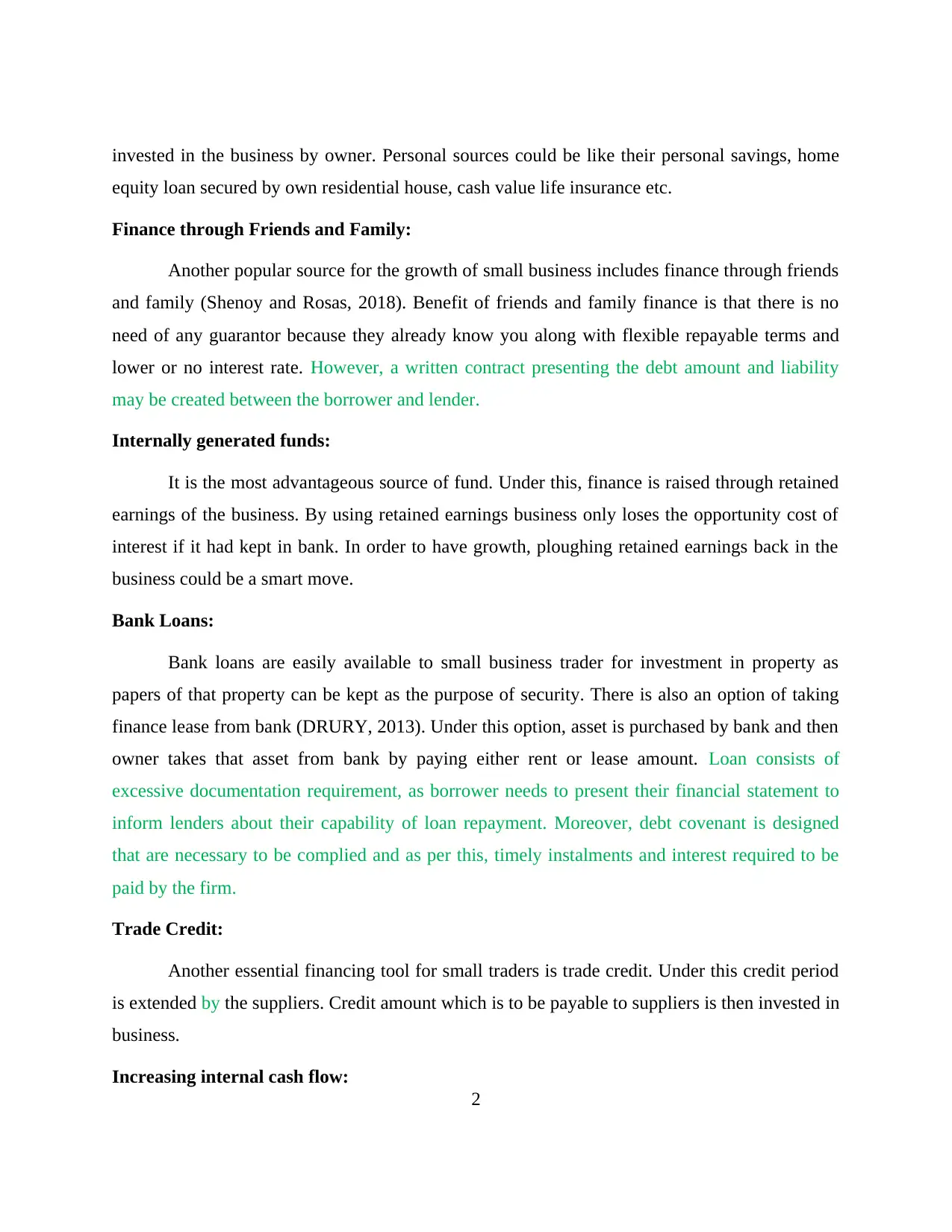
invested in the business by owner. Personal sources could be like their personal savings, home
equity loan secured by own residential house, cash value life insurance etc.
Finance through Friends and Family:
Another popular source for the growth of small business includes finance through friends
and family (Shenoy and Rosas, 2018). Benefit of friends and family finance is that there is no
need of any guarantor because they already know you along with flexible repayable terms and
lower or no interest rate. However, a written contract presenting the debt amount and liability
may be created between the borrower and lender.
Internally generated funds:
It is the most advantageous source of fund. Under this, finance is raised through retained
earnings of the business. By using retained earnings business only loses the opportunity cost of
interest if it had kept in bank. In order to have growth, ploughing retained earnings back in the
business could be a smart move.
Bank Loans:
Bank loans are easily available to small business trader for investment in property as
papers of that property can be kept as the purpose of security. There is also an option of taking
finance lease from bank (DRURY, 2013). Under this option, asset is purchased by bank and then
owner takes that asset from bank by paying either rent or lease amount. Loan consists of
excessive documentation requirement, as borrower needs to present their financial statement to
inform lenders about their capability of loan repayment. Moreover, debt covenant is designed
that are necessary to be complied and as per this, timely instalments and interest required to be
paid by the firm.
Trade Credit:
Another essential financing tool for small traders is trade credit. Under this credit period
is extended by the suppliers. Credit amount which is to be payable to suppliers is then invested in
business.
Increasing internal cash flow:
2
equity loan secured by own residential house, cash value life insurance etc.
Finance through Friends and Family:
Another popular source for the growth of small business includes finance through friends
and family (Shenoy and Rosas, 2018). Benefit of friends and family finance is that there is no
need of any guarantor because they already know you along with flexible repayable terms and
lower or no interest rate. However, a written contract presenting the debt amount and liability
may be created between the borrower and lender.
Internally generated funds:
It is the most advantageous source of fund. Under this, finance is raised through retained
earnings of the business. By using retained earnings business only loses the opportunity cost of
interest if it had kept in bank. In order to have growth, ploughing retained earnings back in the
business could be a smart move.
Bank Loans:
Bank loans are easily available to small business trader for investment in property as
papers of that property can be kept as the purpose of security. There is also an option of taking
finance lease from bank (DRURY, 2013). Under this option, asset is purchased by bank and then
owner takes that asset from bank by paying either rent or lease amount. Loan consists of
excessive documentation requirement, as borrower needs to present their financial statement to
inform lenders about their capability of loan repayment. Moreover, debt covenant is designed
that are necessary to be complied and as per this, timely instalments and interest required to be
paid by the firm.
Trade Credit:
Another essential financing tool for small traders is trade credit. Under this credit period
is extended by the suppliers. Credit amount which is to be payable to suppliers is then invested in
business.
Increasing internal cash flow:
2
Paraphrase This Document
Need a fresh take? Get an instant paraphrase of this document with our AI Paraphraser

Need of purchasing a building is often forecasted earlier. Hence, by then, increasing cash
flow within business in the way of increasing profit margin on products and services, cutting cost
of services, managing working capital, selling off old assets or by recovering debts earlier,
business can generate more cash (Sources of funds, 2017).
Issuing share capital:
Issue of share capital, is generally the least favourable sources of finance for small
business traders because brand image of the business is yet in process and thus less public rely
on them. However, there is an option to owner if he wants to raise finance through issuing share
capital.
The best way for raising finance in order to purchase new building for small trader is
using personal source or through bank loan (Jang and Park, 2011). Because using personal
sources will increase capital in the business that will create a good image of the firm and
therefore, bank loan can be easily available.
Government programs:
With the help of government and grants for the financial institutions which in turn helps
in facilitating the adequate funds for the business operations. The most important benefit
associated with the grant is that it does not need any repayment if it is utilized in the mentioned
timeframe and for the purpose for which it is given. Thus, the same is its limitation also as grant
is available for specified time or given objective only. Hence, it cannot be used for any other
purpose.
1.2 Methods for generating income in restaurant business
In the competitive world, making restaurant profitable is a difficult task. In order to
survive in a restaurant industry, making high revenue is a key factor, however, in order to
increase revenue, business cannot use wrong practices like charging high from customers,
reducing average volume, etc. Using such practices can push the customers away from the
restaurant. Below are some tactics that can be used by restaurant business to increase their
revenue and make their restaurant profitable:
3
flow within business in the way of increasing profit margin on products and services, cutting cost
of services, managing working capital, selling off old assets or by recovering debts earlier,
business can generate more cash (Sources of funds, 2017).
Issuing share capital:
Issue of share capital, is generally the least favourable sources of finance for small
business traders because brand image of the business is yet in process and thus less public rely
on them. However, there is an option to owner if he wants to raise finance through issuing share
capital.
The best way for raising finance in order to purchase new building for small trader is
using personal source or through bank loan (Jang and Park, 2011). Because using personal
sources will increase capital in the business that will create a good image of the firm and
therefore, bank loan can be easily available.
Government programs:
With the help of government and grants for the financial institutions which in turn helps
in facilitating the adequate funds for the business operations. The most important benefit
associated with the grant is that it does not need any repayment if it is utilized in the mentioned
timeframe and for the purpose for which it is given. Thus, the same is its limitation also as grant
is available for specified time or given objective only. Hence, it cannot be used for any other
purpose.
1.2 Methods for generating income in restaurant business
In the competitive world, making restaurant profitable is a difficult task. In order to
survive in a restaurant industry, making high revenue is a key factor, however, in order to
increase revenue, business cannot use wrong practices like charging high from customers,
reducing average volume, etc. Using such practices can push the customers away from the
restaurant. Below are some tactics that can be used by restaurant business to increase their
revenue and make their restaurant profitable:
3
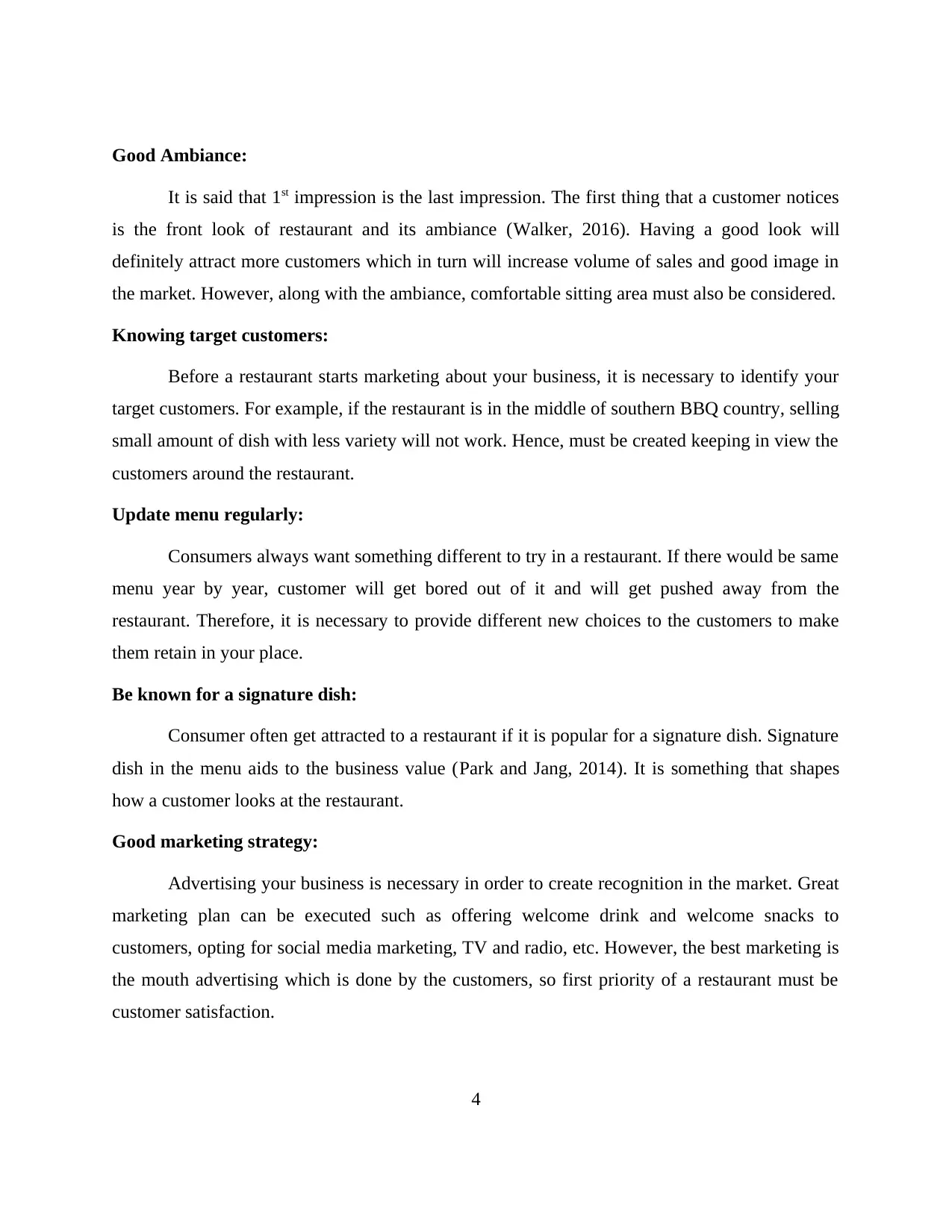
Good Ambiance:
It is said that 1st impression is the last impression. The first thing that a customer notices
is the front look of restaurant and its ambiance (Walker, 2016). Having a good look will
definitely attract more customers which in turn will increase volume of sales and good image in
the market. However, along with the ambiance, comfortable sitting area must also be considered.
Knowing target customers:
Before a restaurant starts marketing about your business, it is necessary to identify your
target customers. For example, if the restaurant is in the middle of southern BBQ country, selling
small amount of dish with less variety will not work. Hence, must be created keeping in view the
customers around the restaurant.
Update menu regularly:
Consumers always want something different to try in a restaurant. If there would be same
menu year by year, customer will get bored out of it and will get pushed away from the
restaurant. Therefore, it is necessary to provide different new choices to the customers to make
them retain in your place.
Be known for a signature dish:
Consumer often get attracted to a restaurant if it is popular for a signature dish. Signature
dish in the menu aids to the business value (Park and Jang, 2014). It is something that shapes
how a customer looks at the restaurant.
Good marketing strategy:
Advertising your business is necessary in order to create recognition in the market. Great
marketing plan can be executed such as offering welcome drink and welcome snacks to
customers, opting for social media marketing, TV and radio, etc. However, the best marketing is
the mouth advertising which is done by the customers, so first priority of a restaurant must be
customer satisfaction.
4
It is said that 1st impression is the last impression. The first thing that a customer notices
is the front look of restaurant and its ambiance (Walker, 2016). Having a good look will
definitely attract more customers which in turn will increase volume of sales and good image in
the market. However, along with the ambiance, comfortable sitting area must also be considered.
Knowing target customers:
Before a restaurant starts marketing about your business, it is necessary to identify your
target customers. For example, if the restaurant is in the middle of southern BBQ country, selling
small amount of dish with less variety will not work. Hence, must be created keeping in view the
customers around the restaurant.
Update menu regularly:
Consumers always want something different to try in a restaurant. If there would be same
menu year by year, customer will get bored out of it and will get pushed away from the
restaurant. Therefore, it is necessary to provide different new choices to the customers to make
them retain in your place.
Be known for a signature dish:
Consumer often get attracted to a restaurant if it is popular for a signature dish. Signature
dish in the menu aids to the business value (Park and Jang, 2014). It is something that shapes
how a customer looks at the restaurant.
Good marketing strategy:
Advertising your business is necessary in order to create recognition in the market. Great
marketing plan can be executed such as offering welcome drink and welcome snacks to
customers, opting for social media marketing, TV and radio, etc. However, the best marketing is
the mouth advertising which is done by the customers, so first priority of a restaurant must be
customer satisfaction.
4
⊘ This is a preview!⊘
Do you want full access?
Subscribe today to unlock all pages.

Trusted by 1+ million students worldwide
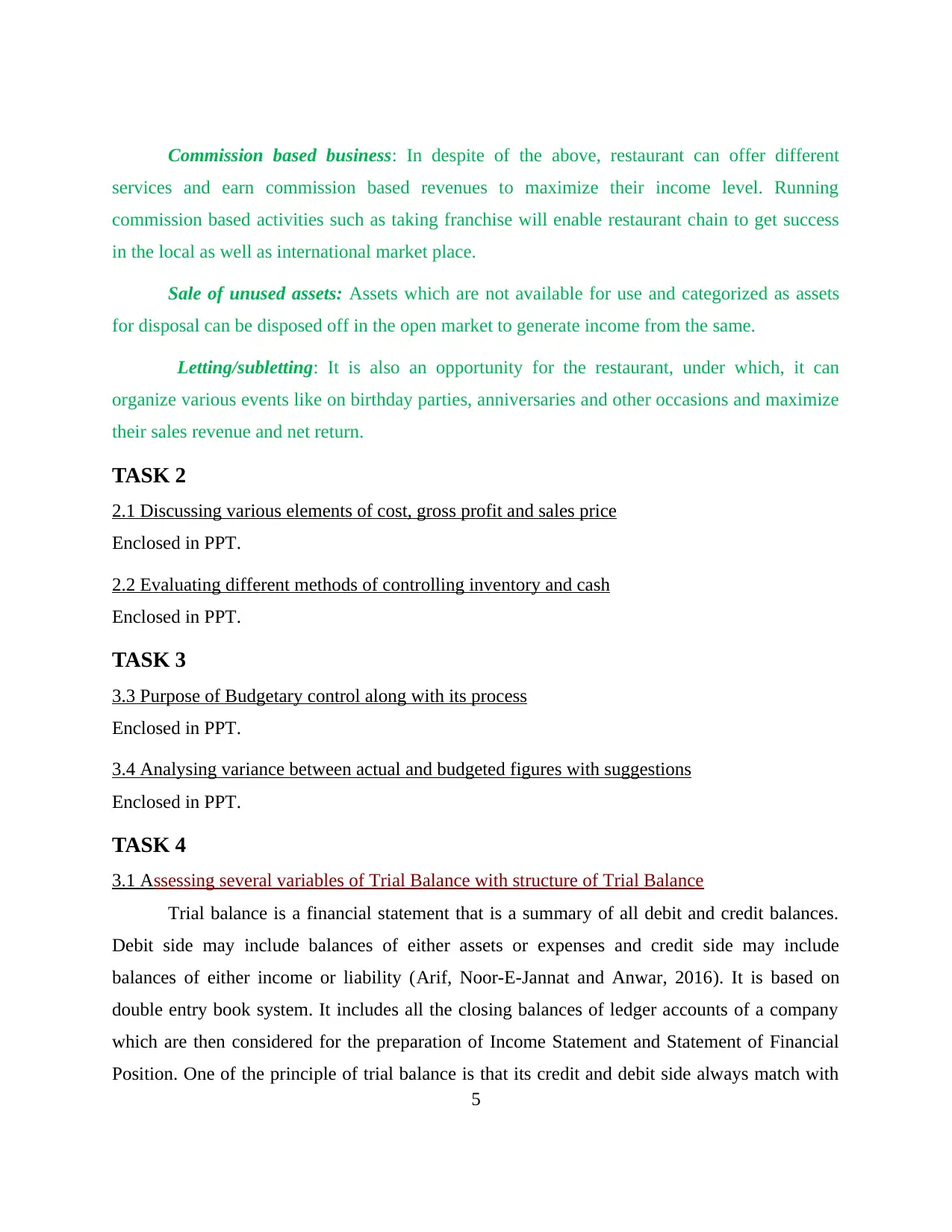
Commission based business: In despite of the above, restaurant can offer different
services and earn commission based revenues to maximize their income level. Running
commission based activities such as taking franchise will enable restaurant chain to get success
in the local as well as international market place.
Sale of unused assets: Assets which are not available for use and categorized as assets
for disposal can be disposed off in the open market to generate income from the same.
Letting/subletting: It is also an opportunity for the restaurant, under which, it can
organize various events like on birthday parties, anniversaries and other occasions and maximize
their sales revenue and net return.
TASK 2
2.1 Discussing various elements of cost, gross profit and sales price
Enclosed in PPT.
2.2 Evaluating different methods of controlling inventory and cash
Enclosed in PPT.
TASK 3
3.3 Purpose of Budgetary control along with its process
Enclosed in PPT.
3.4 Analysing variance between actual and budgeted figures with suggestions
Enclosed in PPT.
TASK 4
3.1 Assessing several variables of Trial Balance with structure of Trial Balance
Trial balance is a financial statement that is a summary of all debit and credit balances.
Debit side may include balances of either assets or expenses and credit side may include
balances of either income or liability (Arif, Noor-E-Jannat and Anwar, 2016). It is based on
double entry book system. It includes all the closing balances of ledger accounts of a company
which are then considered for the preparation of Income Statement and Statement of Financial
Position. One of the principle of trial balance is that its credit and debit side always match with
5
services and earn commission based revenues to maximize their income level. Running
commission based activities such as taking franchise will enable restaurant chain to get success
in the local as well as international market place.
Sale of unused assets: Assets which are not available for use and categorized as assets
for disposal can be disposed off in the open market to generate income from the same.
Letting/subletting: It is also an opportunity for the restaurant, under which, it can
organize various events like on birthday parties, anniversaries and other occasions and maximize
their sales revenue and net return.
TASK 2
2.1 Discussing various elements of cost, gross profit and sales price
Enclosed in PPT.
2.2 Evaluating different methods of controlling inventory and cash
Enclosed in PPT.
TASK 3
3.3 Purpose of Budgetary control along with its process
Enclosed in PPT.
3.4 Analysing variance between actual and budgeted figures with suggestions
Enclosed in PPT.
TASK 4
3.1 Assessing several variables of Trial Balance with structure of Trial Balance
Trial balance is a financial statement that is a summary of all debit and credit balances.
Debit side may include balances of either assets or expenses and credit side may include
balances of either income or liability (Arif, Noor-E-Jannat and Anwar, 2016). It is based on
double entry book system. It includes all the closing balances of ledger accounts of a company
which are then considered for the preparation of Income Statement and Statement of Financial
Position. One of the principle of trial balance is that its credit and debit side always match with
5
Paraphrase This Document
Need a fresh take? Get an instant paraphrase of this document with our AI Paraphraser

each other. If there is any variance among the figures of debit and credit side, this reflects error
in either journal entry or ledger posting. Hence, the main sources of trial balance are Journal
entries and Ledger accounts.
Trial balance is prepared in the structure, presented below:
Figure 1 Structure of trial balance
Journal Entries: It is the entry to the journal book of the organisation. The first step of
recording business transactions is recording of journal entries. These are recorded in
chronological order on the basis of date of transaction. These entries are then posted to the
specific ledger accounts.
Ledger accounts: It is a record of all the journal entries which is used to store and sort income
statement and balance sheet transaction (Sargeant and Jay, 2014). Some examples of ledger
account are cash A/C, sales A/C, accounts receivables, investment, inventories, interest received,
accounts payable, etc. losing balances of these accounts are then transferred to Trial Balance,
which is the summary of ledger account.
6
in either journal entry or ledger posting. Hence, the main sources of trial balance are Journal
entries and Ledger accounts.
Trial balance is prepared in the structure, presented below:
Figure 1 Structure of trial balance
Journal Entries: It is the entry to the journal book of the organisation. The first step of
recording business transactions is recording of journal entries. These are recorded in
chronological order on the basis of date of transaction. These entries are then posted to the
specific ledger accounts.
Ledger accounts: It is a record of all the journal entries which is used to store and sort income
statement and balance sheet transaction (Sargeant and Jay, 2014). Some examples of ledger
account are cash A/C, sales A/C, accounts receivables, investment, inventories, interest received,
accounts payable, etc. losing balances of these accounts are then transferred to Trial Balance,
which is the summary of ledger account.
6

As per the given scenario, R Rigs have not recorded two transactions in its records. The
same are been recorded below:
7
same are been recorded below:
7
⊘ This is a preview!⊘
Do you want full access?
Subscribe today to unlock all pages.

Trusted by 1+ million students worldwide

Interpretation: On the basis of above calculations for the journal entries the business
will be able to make the adequate efforts in the operational activities of the business. Furniture is
being purchased for the amount of 525 will be debited, bank account will be debited for the
interest received amounted to 500. Further, there has been various adjusted entries for the trail
balance such as cash at bank, interest furniture and creditors which together brings the total
balance for 1025.
8
will be able to make the adequate efforts in the operational activities of the business. Furniture is
being purchased for the amount of 525 will be debited, bank account will be debited for the
interest received amounted to 500. Further, there has been various adjusted entries for the trail
balance such as cash at bank, interest furniture and creditors which together brings the total
balance for 1025.
8
Paraphrase This Document
Need a fresh take? Get an instant paraphrase of this document with our AI Paraphraser
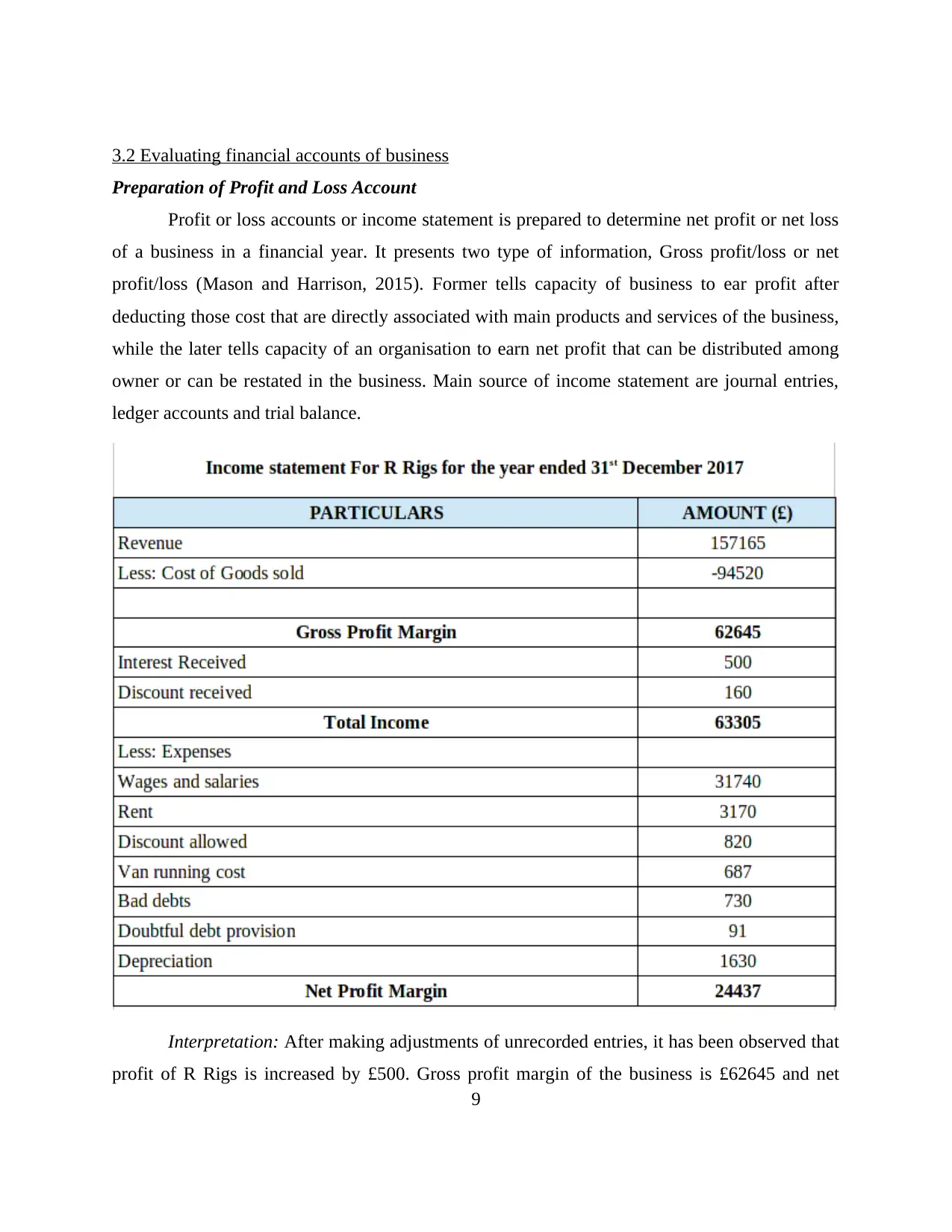
3.2 Evaluating financial accounts of business
Preparation of Profit and Loss Account
Profit or loss accounts or income statement is prepared to determine net profit or net loss
of a business in a financial year. It presents two type of information, Gross profit/loss or net
profit/loss (Mason and Harrison, 2015). Former tells capacity of business to ear profit after
deducting those cost that are directly associated with main products and services of the business,
while the later tells capacity of an organisation to earn net profit that can be distributed among
owner or can be restated in the business. Main source of income statement are journal entries,
ledger accounts and trial balance.
Interpretation: After making adjustments of unrecorded entries, it has been observed that
profit of R Rigs is increased by £500. Gross profit margin of the business is £62645 and net
9
Preparation of Profit and Loss Account
Profit or loss accounts or income statement is prepared to determine net profit or net loss
of a business in a financial year. It presents two type of information, Gross profit/loss or net
profit/loss (Mason and Harrison, 2015). Former tells capacity of business to ear profit after
deducting those cost that are directly associated with main products and services of the business,
while the later tells capacity of an organisation to earn net profit that can be distributed among
owner or can be restated in the business. Main source of income statement are journal entries,
ledger accounts and trial balance.
Interpretation: After making adjustments of unrecorded entries, it has been observed that
profit of R Rigs is increased by £500. Gross profit margin of the business is £62645 and net
9
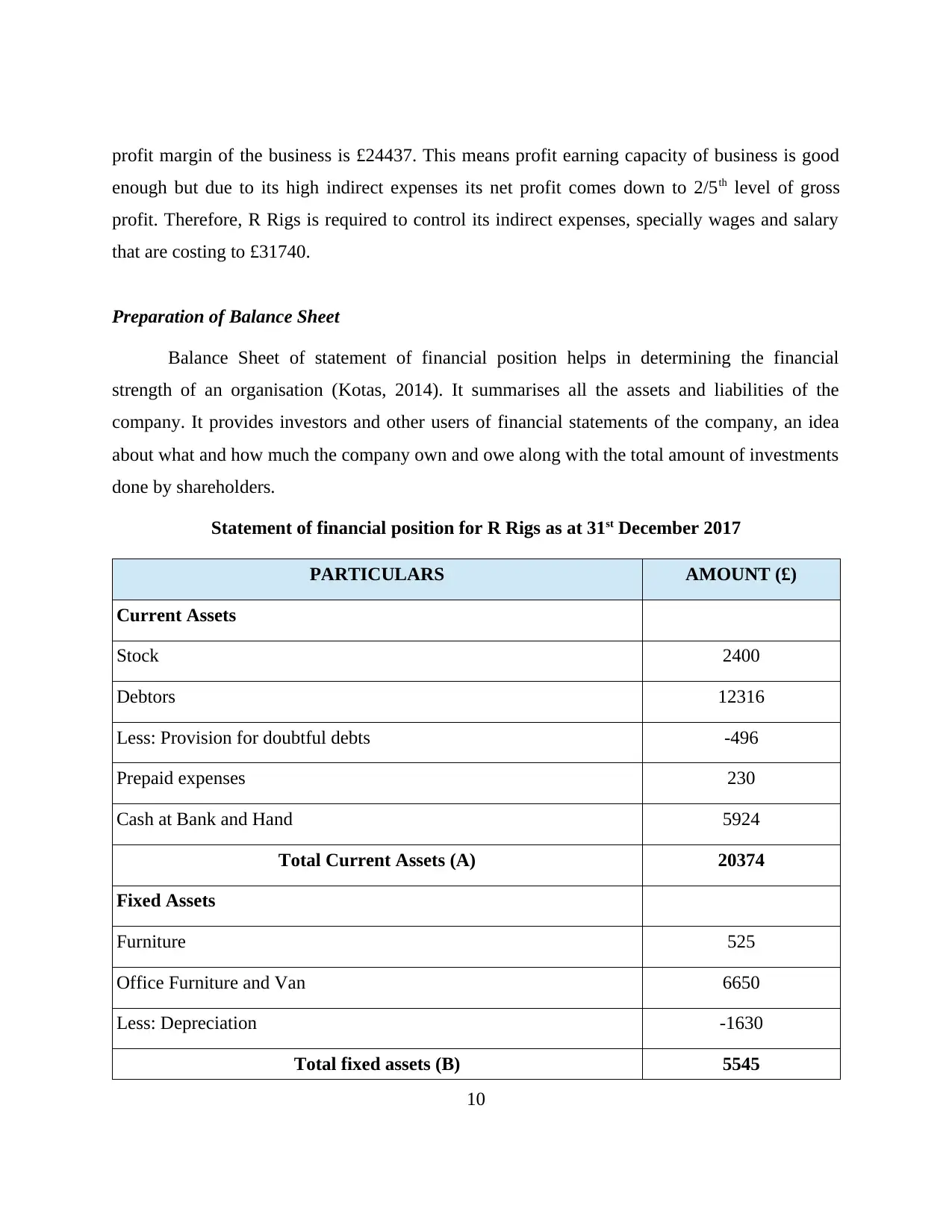
profit margin of the business is £24437. This means profit earning capacity of business is good
enough but due to its high indirect expenses its net profit comes down to 2/5th level of gross
profit. Therefore, R Rigs is required to control its indirect expenses, specially wages and salary
that are costing to £31740.
Preparation of Balance Sheet
Balance Sheet of statement of financial position helps in determining the financial
strength of an organisation (Kotas, 2014). It summarises all the assets and liabilities of the
company. It provides investors and other users of financial statements of the company, an idea
about what and how much the company own and owe along with the total amount of investments
done by shareholders.
Statement of financial position for R Rigs as at 31st December 2017
PARTICULARS AMOUNT (£)
Current Assets
Stock 2400
Debtors 12316
Less: Provision for doubtful debts -496
Prepaid expenses 230
Cash at Bank and Hand 5924
Total Current Assets (A) 20374
Fixed Assets
Furniture 525
Office Furniture and Van 6650
Less: Depreciation -1630
Total fixed assets (B) 5545
10
enough but due to its high indirect expenses its net profit comes down to 2/5th level of gross
profit. Therefore, R Rigs is required to control its indirect expenses, specially wages and salary
that are costing to £31740.
Preparation of Balance Sheet
Balance Sheet of statement of financial position helps in determining the financial
strength of an organisation (Kotas, 2014). It summarises all the assets and liabilities of the
company. It provides investors and other users of financial statements of the company, an idea
about what and how much the company own and owe along with the total amount of investments
done by shareholders.
Statement of financial position for R Rigs as at 31st December 2017
PARTICULARS AMOUNT (£)
Current Assets
Stock 2400
Debtors 12316
Less: Provision for doubtful debts -496
Prepaid expenses 230
Cash at Bank and Hand 5924
Total Current Assets (A) 20374
Fixed Assets
Furniture 525
Office Furniture and Van 6650
Less: Depreciation -1630
Total fixed assets (B) 5545
10
⊘ This is a preview!⊘
Do you want full access?
Subscribe today to unlock all pages.

Trusted by 1+ million students worldwide
1 out of 22
Related Documents
Your All-in-One AI-Powered Toolkit for Academic Success.
+13062052269
info@desklib.com
Available 24*7 on WhatsApp / Email
![[object Object]](/_next/static/media/star-bottom.7253800d.svg)
Unlock your academic potential
Copyright © 2020–2025 A2Z Services. All Rights Reserved. Developed and managed by ZUCOL.





